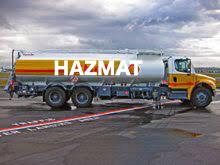- Log in to post comments

Hazmat Endorsement?
The CDL Hazmat Endorsement is a qualification that allows a commercial driver to transport hazardous materials. To obtain this endorsement, the driver must pass a written exam and possibly a skills test, depending on the state in which they are applying. The exam will test the driver's knowledge of federal regulations, handling and emergency procedures, and placarding and labeling requirements for hazardous materials. In addition, the driver must pass a background check and be cleared to handle hazardous materials
CDL HazMat Endorsement Practice Test
Are you looking to operate a vehicle that transports hazardous materials? If so, you'll need to pass the CDL Hazmat Endorsement exam in order to be qualified to do so. This exam consists of 30 questions, and you'll need to score at least 80% (or 24 out of 30 questions) in order to pass. It's important to note that this endorsement is required for anyone who operates a vehicle that transports hazardous materials, and you'll need to be retested every two years to maintain your qualification. To help you prepare for the exam, be sure to practice with our quiz or review the CDL manual thoroughly. With the right preparation, you can successfully pass the CDL Hazmat Endorsement exam and confidently operate vehicles carrying hazardous materials.
- Code:H
- Class A or B
- Number of questions : 30 questions
- Pass rate : 80%
- Pass Correct Answers : 24 Correct answer
- How need It : Needed for operators of vehicles transporting hazardous materials.
- Special Requirement: Must be trained and retested every two years.
- How to pass the exam successfully: Practice well on the quiz below or read the CDL manual
Understanding the Hazmat Endorsement: Who Needs It?
The Hazmat Endorsement, short for "Hazardous Materials Endorsement," is required for drivers who transport hazardous materials as defined by the Department of Transportation (DOT) in the United States. Anyone who operates a commercial motor vehicle (CMV) transporting hazardous materials in quantities that require placarding must have a Hazmat Endorsement on their commercial driver's license (CDL).
This endorsement is essential for truck drivers, delivery drivers, and others who handle or transport hazardous materials such as chemicals, gases, flammable liquids, explosives, and radioactive materials. To obtain the endorsement, drivers typically need to pass a written test on handling hazardous materials and undergo a background check conducted by the Transportation Security Administration (TSA).
Vehicle Requirements for Transporting Hazardous Materials
Vehicles used for transporting hazardous materials must meet specific safety requirements to minimize risks associated with handling and transporting dangerous substances. These requirements vary depending on the type of hazardous materials being transported, but some common features include:
- 1. Specialized Equipment: Vehicles may be equipped with specialized features such as leak-proof tanks, compartments, or containment systems designed to prevent spills or leaks during transportation.
- 2. Placarding: Vehicles transporting hazardous materials typically require placards that display standardized symbols and information about the types of materials being transported. This helps emergency responders identify the hazards in case of an accident.
- 3. Safety Equipment: Vehicles may be equipped with safety equipment such as fire extinguishers, spill containment kits, emergency response guides, and personal protective gear to handle potential emergencies.
- 4. Ventilation Systems: Some vehicles may have ventilation systems to control the buildup of fumes or gases inside the cargo area, reducing the risk of combustion or exposure to hazardous substances.
- 5. Security Measures: To prevent unauthorized access to hazardous materials, vehicles may be equipped with security features such as locks, seals, or tracking devices.
- 6. Compliance with Regulations: Vehicles must comply with relevant regulations set forth by government agencies such as the Department of Transportation (DOT) in the United States. These regulations govern various aspects of transportation, including vehicle design, labeling, packaging, and handling procedures.
Overall, vehicles used for transporting hazardous materials are designed and equipped to ensure the safe and secure transportation of potentially dangerous substances while minimizing risks to public safety and the environment.

